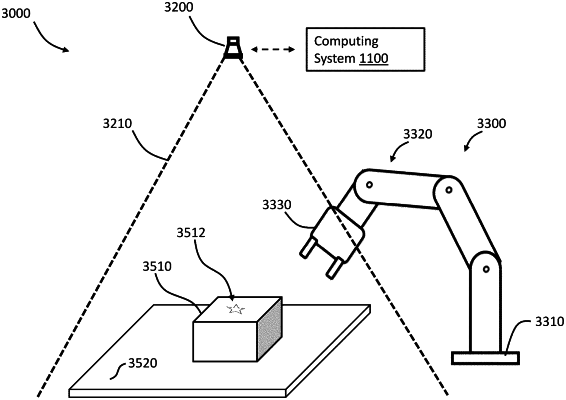| CPC G06V 10/751 (2022.01) [B25J 9/1666 (2013.01); B25J 9/1697 (2013.01); B25J 13/08 (2013.01); G06V 10/25 (2022.01); G06V 10/443 (2022.01); G06V 20/10 (2022.01); G06V 20/647 (2022.01)] | 23 Claims |

|
1. A computing system comprising:
a communication interface configured to communicate with a robot and with a camera having a camera field of view; and
at least one processing circuit configured, when an object is or has been in the camera field of view, to:
receive image information representing the object, wherein the image information is generated by the camera;
identify a set of one or more matching object recognition templates, which are one or more object recognition templates that satisfy a predefined template matching condition when compared against the image information, wherein the set of one or more matching object recognition templates are associated with a set of one or more detection hypotheses, which are one or more respective estimates on which object or object type is represented by the image information;
select, as a primary detection hypothesis, a detection hypothesis from among the set of one or more detection hypotheses, wherein the primary detection hypothesis is associated with a matching object recognition template of the set of one or more matching object recognition templates, wherein the detection hypothesis that is selected as the primary detection hypothesis has a confidence value which is highest among a set of one or more respective confidence values, wherein the set of one or more respective confidence values are associated with the set of one or more detection hypotheses, and indicate respective degrees by which the image information matches the set of one or more matching object recognition templates associated with the set of one or more detection hypotheses;
generate, as a primary candidate region, a candidate region which estimates object boundary locations for the object or estimates which locations in the camera field of view are occupied by the object, wherein the primary candidate region is generated based on the matching object recognition template associated with the primary detection hypothesis;
determine, in addition to the matching object recognition template associated with the primary detection hypothesis, at least one of:
(i) whether the set of one or more matching object recognition templates has a subset of one or more remaining matching object recognition templates that also satisfy the predefined template matching condition when compared against the image information, or
(ii) whether the image information has a portion representing an unmatched region which is adjacent to the primary candidate region and which fails to satisfy the predefined template matching condition;
generate a safety volume list in response to a determination that there is the subset of one or more remaining matching object recognition templates, or that the image information has the portion representing the unmatched region,
wherein the safety volume list is a list that describes at least one of:
(i) the unmatched region, or
(ii) one or more additional candidate regions that also estimate object boundary locations for the object or estimate which locations are occupied by the object, wherein the one or more additional candidate regions are generated based on the subset of one or more remaining matching object recognition templates; and
perform motion planning based on the primary candidate region and based on the safety volume list, wherein the motion planning is for robot interaction between the robot and the object for gripping or picking up the object and moving the object from the occupied location of the object to a destination location.
|